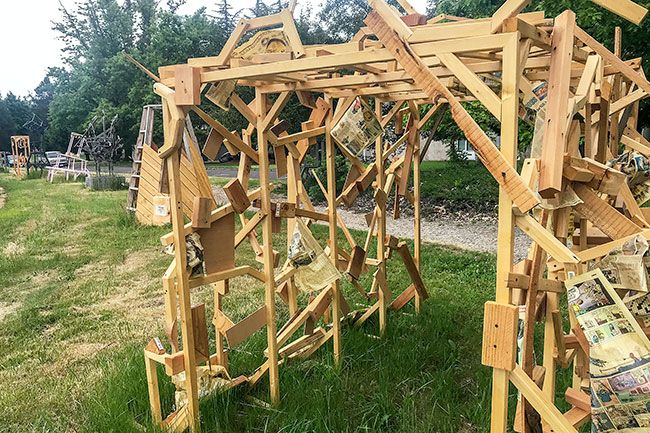Back, and Forth: Sometimes outdoor art features an inside story

One of my favorite things about McMinnville is the art walk on the Linfield University campus.
I have found one of the walk’s newest works, installed two weeks ago, particularly dynamic. It got me immediately thinking about nature of the venerable field of journalism.
Anyone still working in newspapers today harbors some sobering contemplation, including this one: Is this field of endeavor temporary? Are we just pages blowing in the wind?
Marissa Nagano’s “Tunnel” speaks to that idea — at least to me, though it was not necessarily the message intended by the art major from Hawaii.
There’s power to what she created. I immediately, almost viscerally, inferred a sobering meaning upon first encounter.
After looking at it a second and third time, though, I also felt hope. From any perspective, “Tunnel” offers a bracing, yet healthy, gust of fresh air.
Returning to McMinnville 26 months ago, I encountered the art walk for the first time upon trying out the wellness trail on the south side of campus, home of the James F. Miller Fine Arts Center. Part of the art walk features what I call a rotating mural on the northwest corner of the Miller Center, a kind of pivot between the works on the north courtyard and those along the wellness trail.
Twice a year, students adorn the space with a new mural. The current one is a minimalist representation of the wooden tower that was torched in the adjacent field in April, part of the 17th annual “Build to Burn” exhibit organized by instructor Totem Shriver.
I’m frequently drawn to the works along the wellness trail.
It features a row of 20 or so colorful, expressive sculptures. They are mostly fashioned of wood, though some employ metal and other materials.
Each piece is open to interpretation, though some seem to have clear messages. I particularly enjoy revisiting one — a cascade of wood seeming to hang in freeze-frame above a free-standing chair.
I encourage anyone who has not taken in the outdoor gallery to go check it out. Most pieces are out in the open, though a few are nestled in a small grove of trees.
Two were removed this year. One point of the walk is understanding that art is often impermanent, Shriver explained.
But three new ones have been placed in recent weeks, including Nagano’s “Tunnel” and the 9-foot columnar “You and Me.” Both have been crafted of wooden pieces.
Nothing like the Miller Center outdoor gallery, or “Build to Burn,” existed at Linfield in my time there. Art was mostly kept inside in my day.
Some of the sculptures feel scalable.
Artworks should not normally be climbed, but one of the newer works, an eight-foot conical piece, might be the exception. That’s because it features a built-in ladder.
“Tunnel,” fresh from May’s Linfield student exhibit, “Convergence,” is unique on the art walk in that it bears the artist’s name. And it was the piece that most caught my eye.
The 8-by-8 arbor of oddly shaped plywood and lumber pieces does invite human interaction. After all, it’s designed for people to walk underneath it.
The arbor design is wild yet solid, and the wooden-womb shape is appealing. But what most drew me were sheets of newsprint attached loosely at odd angles. The pages — featuring news, sports, ads, comics — blow in the wind.
When I first saw them at sunset, the newsprint was illuminated, like some sort of kinetic stained glass. As a long-time newspaper guy, seeing examples of my craft displayed in this manner left me practically speechless.
I texted Nagano, with this prompt:
“I am fascinated by the temporal element of the loose paper, attached to the harder surface. Papers will weather, tear and blow away. I would love to know more.”
Nagano replied, explaining that she built the piece with the help of Shriver and other students, from the crate full of scrap pieces that intrigued her.
“So once I had the opportunity to have my own studio space, I started to collect scrap pieces. First, I made ‘You and Me.’ However, once that was completed, I kept finding cool looking pieces.
“Also, the art professors kept asking me if I was going to combine my work with sculpture and collage. I said yes, but I didn’t know what I was going to do.”
On a winter break visit to Hawaii, she saw “Awakening” by Rebecca Louise Law at the Honolulu Museum of Art.
“As I was walking through the tunnel of flowers, I thought, ‘This is amazing! I want to make a tunnel!’ That’s how I came up with the idea of making a tunnel combining sculpture and collage.
“The sculptural element was the scrap pieces on the outside of the tunnel … For the collage element, I chose to use newspapers from home because the sun would shine through newspaper easier than magazine paper. I hoped it would melt in the rain, and my grandpa had a lot of it that I could use.”
The hope I found in Nagano’s impressive sculpture employing newsprint designed to fade and fly away?
It appears Nagano did not have this expressly in mind. But I have come to see the news pages on it as part of something permanent — that newspapers and the service they provide will remain, ideally at least — connected to sound and enduring structures.
Kirby Neumann-Rea, the N-R’s managing editor, enjoys books, craft beer, Celtic music and basketball. Contact him at kirby@newsregister.com or 503-687-1291.








Comments